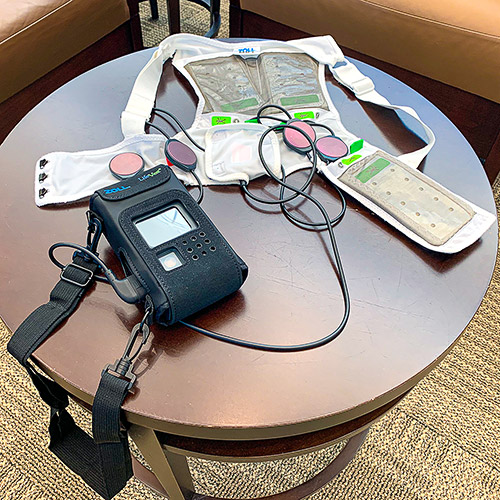Man’s Life Saved by a Wearable Heart Defibrillator
September 16, 2019

How a wearable defibrillator detected a man’s abnormal heart rhythm and saved his life.
After being treated at University Hospitals Ahuja Medical Center for abdominal pain, nausea, vomiting and weight loss, Glynn Crawford’s symptoms subsided, but his underlying conditions – paroxysmal atrial fibrillation and non-ischemic cardiomyopathy – remained. Luckily for him, Glynn’s cardiologist recommended that he be fitted with the LifeVest® wearable defibrillator. Just three days later, the device saved his life.
Heart Dysfunction
Glynn, 68, was diagnosed with cardiomyopathy in November 2018 and a cardiac catheterization in January 2019 confirmed non-ischemic cardiomyopathy – a progressive disease of the heart muscle that makes it difficult for the heart to pump blood throughout the body. Glynn’s type of cardiomyopathy is not associated with coronary artery disease, but rather a mechanical or electrical dysfunction of the heart. Paroxsymal atrial fibrillation is a condition in which irregular heartbeat occurs occasionally.
While he was hospitalized at UH Ahuja Medical Center in late June/early July for chronic abdominal issues associated with his heart condition, UH Harrington Heart & Vascular Institute cardiologist Barbara Williams, MD, found some concerning items on Glynn’s telemetry. He had premature ventricular contractions and new atrial fibrillation – extra heartbeats and an abnormal heart rhythm, respectively. Additionally, on the day of his discharge, she noted that he had eight beats of ventricular tachycardia – fast heartbeat with electrical activity from the ventricles of Glynn’s heart.
LifeVest® Wearable Defibrillator

After prescribing medications to address those concerns, Dr. Williams took an extra step to protect Glynn from sudden cardiac death by recommending a ZOLL LifeVest®. This lightweight, easy-to-wear garment continuously monitors the wearer’s heart. If LifeVest detects a life-threatening rapid heart rhythm, it will automatically deliver a treatment shock to restore the normal rhythm. The device also alerts bystanders when a shock has been delivered so they can contact emergency medical personnel.
“LifeVest® allows physicians to assess a patient’s long-term arrhythmic risk after they leave our care while also providing the life-saving shock of a defibrillator,” said Dr. Williams.
A Life-Saving Shock
Just three days post-discharge, LifeVest® saved Glynn’s life. “I was lying in bed, watching TV and the next thing I knew, I woke up with my wife telling me that the vest had shocked my heart back into rhythm,” said Glynn. “The alarm had alerted her to what was happening and she called 9-1-1. When they arrived, I was able to walk outside to the ambulance myself.”
The following day, an implantable cardioverter defibrillator (ICD) was implanted in Glynn’s chest at UH Ahuja Medical Center. Like LifeVest®, the palm-sized device continuously monitors a patient’s heart and provides an electric shock when needed to help establish a normal heart rhythm.
Grateful for UH and LifeVest
Today, Glynn’s abdominal issues have resolved and his medications are working well to manage his cardiovascular conditions. “I’m feeling good, and I can enjoy food again,” said Glynn. “I’m just so grateful that Dr. Williams suggested I wear LifeVest®. It did what it was supposed to, that’s for sure!”
Related Links
To learn more about UH Harrington Heart & Vascular Institute, visit our site. To learn more about ZOLL LifeVest®, visit zoll.com.


